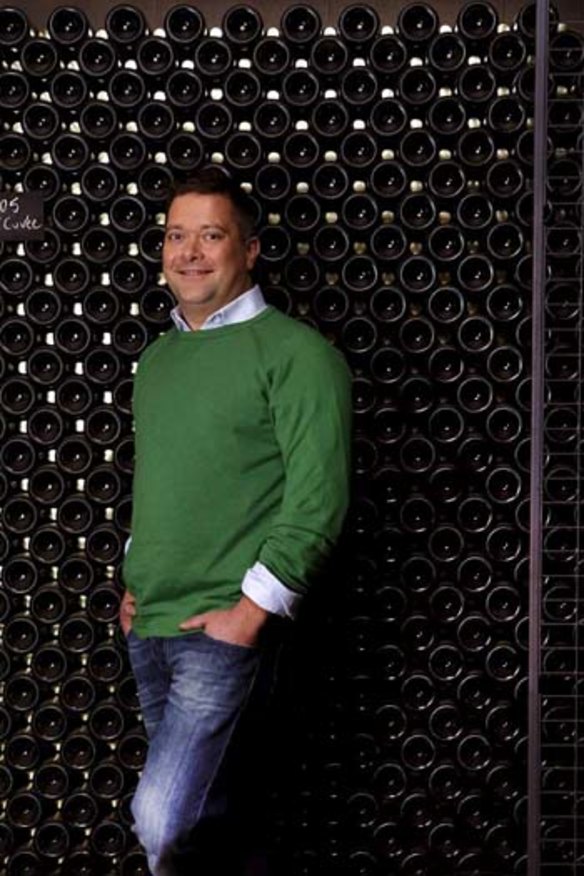Cheap champagne proves a headache for local wine makers

Tasmania's sparkling wine industry would be more competitive with the discount champagne that is arriving in Australia if its grape yields were higher, according to the winner of the 2012 Vin de Champagne award, Dan Buckle.
Buckle, who is the chief winemaker for Domaine Chandon in the Yarra Valley, says grape yields in Champagne are about 12-14 tonnes per hectare, but in Tasmania, only eight to 10 tonnes for sparkling wine. Also, he says, Tasmanian grape growers don't tend to specialise in either table wine or sparkling. This means their pinot noir and chardonnay might be cropped at table-wine levels of five to seven tonnes a hectare, but could end up in sparkling wine. In that case, the cropping level would be unnecessarily low.
Grape yields need to be substantially lower to make good table wine. In France's Champagne region, almost all of the 35,000 hectares of vines are managed for sparkling wine. ''Pinot noir and chardonnay are not as sensitive to yield if you're making sparkling wine,'' Buckle says. He was commenting on the Australian market where good champagne can be bought for as little as $35 a bottle. This puts it on a similar level as Domaine Chandon's Australian vintage sparkling, which retails for about $38 to $40 a bottle.
Currency exchange rates favourable to importers are part of why champagne prices are so low as is direct importing by retailers, which cuts out the middle man. But the cost of production is also a factor and grape yields are an important component of production costs.
As winner of the Vin de Champagne award, professional section, Buckle travelled to Champagne in May for a two-week study tour as a guest of the Comite Champagne, which is the industry body that controls the production and marketing of all champagne wine.
Despite the yield disadvantage of Australian cool-climate regions such as Tasmania, Buckle believes Domaine Chandon sparkling wines are profitable and competitive. Chandon uses grapes from several Victorian and South Australian regions as well as Tasmania. He would like to use more Tasmanian grapes, but the cost of shipping them on ferries is an issue. Chandon brings all of its Tasmanian grapes across Bass Strait as whole fruit, while some companies, such as Hardys, press their grapes in Tasmania and ship the juice across.
Buckle says his time in Champagne was illuminating. A highlight was a multi-vintage tasting of Dom Perignon. Another was visiting Moet's private research facility. Buckle is enthusiastic about the possibility of Chandon Australia getting involved in some of Moet's research projects. One opportunity could be studying the quality of various pressing fractions. Champagne law allows the first 500 litres of each tonne of grapes to be treated as the ''cuvee''; another 100 litres is premier taille (first pressing) and the last 50 litres is deuxieme taille. But Buckle thinks it's quite likely there is a ''sweet spot'' somewhere between 150 and 400 litres that could be the best juice, and this could be diverted for higher-quality prestige wines. He also found phenolics (tannins) were a big talking point in Champagne, especially among the small growers whose wines are fashionable.
''We've always talked about phenolics in sparkling wine as a negative,'' he says, ''but they can be very interesting at subtle levels, giving textural differences. There might also be flavour compounds, close to the skin, and these could be utilised.''
Oak is another big issue in champagne, especially with small growers. ''It certainly makes some interesting wines, adding complexity, and oak tannins are a part of it - for better or worse,'' Buckle says.
Domaine Chandon will soon release a new super-cuvee 2008 Vintage Collection ($45).
Storm in a whine glass
Dan Buckle's Vin de Champagne award win caused a kerfuffle in Champagne because he is an employee of Domaine Chandon Australia. DCA is wholly owned by luxury goods giant Louis Vuitton Moet Hennessy, which also owns the biggest champagne company, Moet et Chandon.
Normally, Vin de Champagne award winners visit a wide spectrum of champagne houses on their two-week study trip, but some of them declined to welcome Buckle. This is unheard of in the 40-year history of the award.
To avoid upsetting people, Buckle decided to restrict his visit to Moet et Chandon and other houses owned by LVMH. These included Veuve Clicquot, Krug, Dom Perignon and Mercier.
Judged every two years, the Vin de Champagne award is for Australians only. It's presented after a three-stage process (written exam, then a tasting, then a verbal exam) for knowledge and tasting skill. Last year when Buckle won, the judges included Sydney wine educator Peter Bourne, Brisbane wine educator Bernadette O'Shea, both past award winners, and me. Buckle was a clear winner, a decision given extra weight by the fact that a guest on the judging panel was the new communications director for the Comite Champagne, Thibaut Le Mailloux.
Moet et Chandon, as the region's biggest producer, contributes most to the industry-funded Comite Champagne. If Moet was aggrieved that it was not able to get its pound of flesh from the committee, other champagne houses were also aggrieved that their industry's award had gone to one of their competitors - namely, the big company others love to hate.
The Vin de Champagne award is in two parts. The professional section is for people who work in the liquor and catering trades, and entrants typically include sommeliers, retailers, writers, winemakers and other members of the liquor and restaurant industries. The non-professional section is for everyone else, and last year was won by Sydney solicitor Matthew Stutsel.
